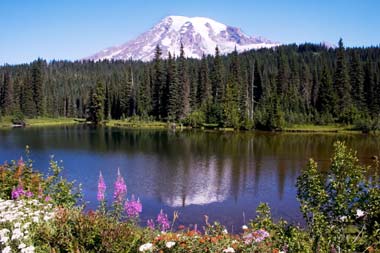
The state’s three national parks (Rainier, Olympic, and North Cascades) each protect different geological superlatives. At Mount Rainier it’s easy access to the most extensive network of glaciers outside Alaska. In Olympic National Park the treasures are twofold — the longest unbroken chain of wild coast in the continental United States (over 50 miles) and stupendous rain forests, both easily accessible from U.S. Highway 101 on the west side of the park. North Cascades Park encompasses the most spectacular alpine wilderness in the lower 48 states. Even day hikers can tramp to the periphery on trails such as Cascade Pass and Hidden Lake Peak (via Marblemount) and several more trails starting along North Cascades Highway (Thornton Lakes, Crater Mountain, Easy Pass).
Federal Wilderness Areas are strung like jewels on the spine of the Cascade Mountains. The Alpine Lakes Wilderness (about an hour’s drive east of Seattle) protects some 500 lakes set in meadows and crags and forests. Glacier Peak Wilderness east of Darrington guards access to its remote namesake volcano, perfect for long climbing and extended pack trips by foot or horse. The Pasayten Wilderness, on the Cascades’ east flank next to Canada, is the largest in the state, a remote stronghold of rugged highlands, rivers, lakes, and forests. It’s famous for good fishing and solitude. Mount Baker Wilderness east of Bellingham protects one of the grandest, and most accessible, combinations of glacial ice and alpine flower meadows in the Northwest.
In the south Cascades, major wildernesses such as Justice Douglas, Mount Adams, Indian Heaven, Goat Rocks (and several new, smaller tracts) protect diverse geology and are favored by horsemen and hikers.
Mount St. Helens National Volcanic Monument memorializes the terrific eruption that blew much of the mountain apart in May 1980 — and the land’s amazing rebirth since then. Take SR 504 eastward from Castle Rock and I-5, past four interpretive centers and several overlooks to Coldwater Ridge, just a few miles from the crater. In 1996, the road was extended 9 miles to the new Johnston Ridge Observatory, which will focus on geology.
Juniper Dunes Wilderness just northeast of the Tri-Cities is a good example of eastern Washington’s arid deserts. Some 7,000 acres of shifting sand dunes await exploration. North of here lies “coulee country,” a vast expanse of ancient lava flows later scoured into “channeled scablands” by the monumental Missoula Floods that repeatedly roared over the region at the end of the last ice age. Today, this is a landscape of cliffs, canyons, and mesas; of sagebrush and wildflowers and scattered clusters of potholes and seep lakes. This “water in the desert” invites a wonderful diversity of summer recreation — boating, fishing, camping, canoeing, wildlife watching, picnicking, and hiking. Coulee Dam National Recreation Area on Roosevelt Lake is just one place to start exploring.